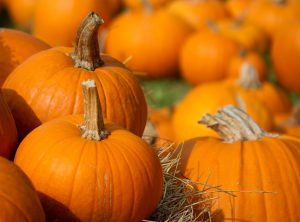Now that it is finally starting to feel like autumn here in north Florida, I have begun to see more and more fall-themed decorations. While the leaves may not change color as much as they do farther north, we do have easy access to another autumn staple: pumpkins.
Pumpkins can be grown in Florida. They are part of the cucurbit family of vegetables that includes other winter and summer squashes such as acorn, butternut, lemon, and zucchini. The four species of pumpkins include pepo, moschata, mixta, and maxima. They have a coarse, strongly flavored flesh and rinds whose hardness falls between that of winter (hard) and summer (soft) squashes.

Pumpkins are an autumn staple, providing not just festive decorations, but also nutritious additions to meals and desserts. (Photo source: Amy Stuart, UF/IFAS)
The three major categories of pumpkins are carving pumpkins, pie pumpkins, and ornamental pumpkins. Each type has its own unique characteristics. Carving pumpkins are large and have smooth, orange, and slightly ribbed skin. Pie pumpkins are smaller, have a sweeter taste, and bright, firm flesh. Ornamental pumpkins are tiny, about 3-4 inches in diameter, and can be orange, white, or variegated.
Pumpkins, like tomatoes, are botanically fruits, but are commercially considered vegetables. While their rinds are generally not edible, both their flesh and seeds can be eaten. Pumpkin can be canned, pureed, roasted, and made into soups, stews, and, of course, pies. Pumpkin seeds are most commonly roasted and eaten on their own as a snack or added to salads and other dishes for a bit of delicious crunch.
As a food source, pumpkins are very nutritious. They are low in fat, calories, sugar, and sodium. A single serving of pumpkin contains 10% of the daily value of potassium and 3 grams of fiber, both of which are vital to good health. Pumpkin also contains a variety of other beneficial nutrients such as vitamin C, calcium, and iron. However, pumpkin is a vitamin A powerhouse. One serving contains 250% of the daily value of this vitamin, which helps promote healthy eyes, skin, and bones. In fact, the beta carotene in pumpkins, which our bodies convert to vitamin A, is what gives pumpkins their vibrant orange color.
According to the University of Florida IFAS, most pumpkin varieties need around four months to reach maturity. To be ready for Halloween, pumpkins should be planted no later than early July. Spring pumpkins planted in March or April can be stored for use in October and November if stored properly in a cool, dry place.
When carving pumpkins, be sure to use the proper tools. Remove the seeds and pulp, and save the seeds for roasting and/or planting. When preparing pumpkins for canning, use smaller sugar or pie pumpkins. Cut them into cubes and do not mash or puree them. When making pumpkin pie, choose the smaller, sweeter pumpkins for the best flavor. Commercially canned pumpkin also can be used to make pumpkin pie.
One final note: do not confuse gourds and pumpkins. While, technically, all pumpkins can be considered gourds, not all gourds are edible. What we think of as gourds are usually the hard, bumpy things with the hollow center that are commonly found in fall decorations. While they are part of the same cucurbit family, they are primarily grown for ornamentation, utensils, and general interest.
Nothing says autumn like a few festive pumpkins. Whether used for a scary Halloween jack-o’-lantern, as a centerpiece for fall decorations, or as an ingredient in a delicious fall dessert, pumpkins are definitely the stars of autumn.
For more information about pumpkins, please call Samantha Kennedy, Family and Consumer Sciences agent, at 850.926.3931.
Additional Resources:
Florida Pumpkins – UF/IFAS Extension
Perfectly Pumpkin Recipe Collection – University of Nebraska – Lincoln Extension
Pumpkin carving: The history of the jack-o’-lantern – Michigan State University Extension
Extension classes are open to everyone regardless of race, creed, color, religion, age, disability, sex, sexual orientation, marital status, national origin, political opinions or affiliations.
- Plugging Spending Leaks - October 24, 2025
- Pets are Good for Mental Health - September 26, 2025
- Develop a Family Emergency Plan for Hurricane Season - June 30, 2025
